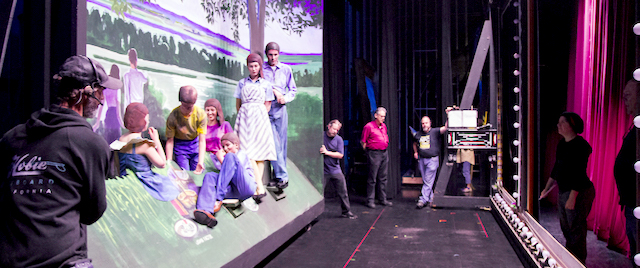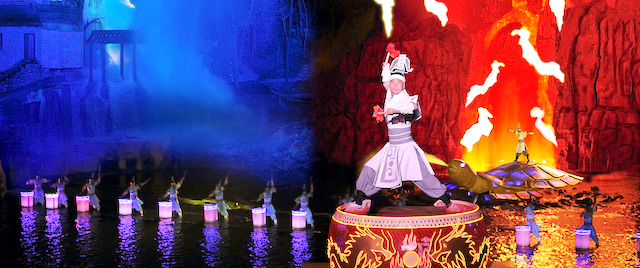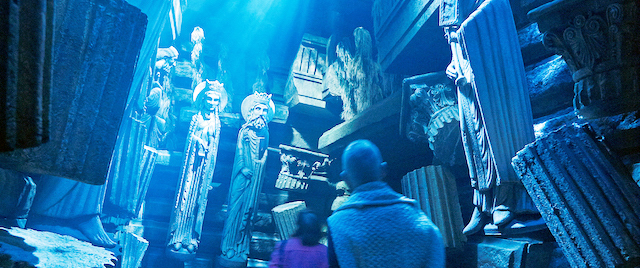Theme parks can stage some ridiculously wild live productions. Think about Fantasmic! on the Rivers of America at Disneyland, Waterworld at Universal Studios Hollywood, or the multimedia wizardry of the new Bourne Stuntacular across the country at Universal Orlando. But even the biggest theme park productions can't match the scale of some of the great live shows around the world.
The Themed Entertainment Association continued its 2020 Thea Awards Case Studies this morning with a look at three great examples, including this year's Thea Classic winner, Pageant of the Masters in Laguna Beach, Calif.

This production began in 1933 and has been entertaining thousands of guests since then with its "Tableaux Vivant" that recreates famous paintings and other artworks with live actors on stage, under the stars.
"In taking a two-dimension painting, we create it with three-dimensional people, and then we've got to turn it back into a two-dimensional scene," said Pageant of the Masters Director Diane Challis Davy. "We want the audience to think that they're not seeing three-dimensional people, but a very flat picture, and I will let you in on a secret, how we do it is we eliminate all natural shadows from our scene. And we rehearse late into the night every Thursday night throughout the winter and spring, rehearsing the lighting trying to get it just right."
It's not just lighting, but set design, background painting, makeup, and legions of volunteers who perform on stage and backstage that help bring art to life for the show.
"Most people really love art. They like looking at art. It touches something in your imagination — that you as a person could walk into that world of the picture and become part of that artist's imaginary magical world," she said. "So you add the storytelling; you add the live music, and [you] enchant people.... Those volunteers are acting out our fantasies of stepping into the world of the painter."
Pageant of the Masters' hundreds of volunteers help recreate about 40 artworks in a 90-minute production, but as impressive as that scale might be, The Legend of the Gods in Weihai, China, delivers an even more audacious experience.

"The theater is built in a quarry measuring 210 meters in length and 171 meters in width, taking advantage of the quarry's topography features," said Bingo Tso, Senior Vice President and CTO of Advanced Communication Equipment, who presented on behalf of the production. "The team of artists and technicians designed and built an open-air Chinese opera house, featuring a series of integrated sets and stages, custom-built to blend into the natural features of the quarry, such as the lake and mountains."
On that lake sits a 2,100-passenger "boat" that's actually the world's largest outdoor mobile audience platform. During the show, it moves to reposition the audience in front of the show sets that line the old quarry's lakeshore.
The show is one of several attractions in the area, which were developed to support the restoration of thousands of acres of deforestation and quarrying, a project that included moving 60 million cubic feet of fill and planting more than 11 million trees. The result here is a one-hour production featuring hundreds of actors, dancers, singers, and acrobats, who bring to life legends and stories from ancient China, highlighted by an erupting volcano, flying dragons and a 5,000-ton waterfall.
Mounting historical productions on a grand scale has become tradition at France's Puy du Fou, which the TEA honored this year for its production Le Premier Royaume, or The First Kingdom.

This is a multi-sensory walkthrough production that immerses the audience into the story of the fifth-century Frankish king Clovis I, who united the Franks after the fall of the Roman Empire and the invasion of Attila. The production includes live actors on stage sets enhanced with projection mapping, water curtains, and holographic and strobe effects. But how to put that together to create an experience that engages rather than confuses the audience?
"It's a bit like a film director because when you think about a show, you think about the whole thing that you want to see and you want to experience and you want to feel," said Puy du Fou Artistic Director Nicolas de Villiers. "I want to create this picture that I have in my mind... we call it in France, image d'epinal — it means the picture that everybody has in mind. If I tell you, for example, a cowboy on his horse, you will think about John Wayne with his hat."
"You want to see that as a guest, but you don't know that you want to see that. Our job is to find what are the pictures in the mind of the people as soon as I say Clovis or Le Premier Royaume? What could it be in the mind of the people?" he said.
"The idea is just to listen very carefully to your instinct, to your intuition, and not too much of your brain, because the brain is sometimes leading you in the wrong way. So just listen to the child inside yourself. Stay the child as soon as you start to create, and you will find exactly what people are expecting and what they enjoy, and then it works."
The Thea Awards Digital Case Studies continue on September 17 with presentations on The Google Assistant Ride, Jeff Wayne's The War of the Worlds: The Immersive Experience, and Poverty Encounter. Tickets are available on the TEA website and include access to all past sessions from this year.
TweetThis article has been archived and is no longer accepting comments.